Yeah, sure. but those shots up there are little tiny things. You couldn't be getting any real Quality out of some jerry-rigged fisheye contraption, now, could you?
Actually, yes. But it wasn't Jerry who made this work. And it is a far cry from those cheeze-ball "Widar" optical junk fisheye converters (A.K.A. "Opteka" 0.22x) you see on eBay for 80 bucks. This is a legacy Nikon fisheye lens at work with its highly structured equisolid distortion formula intact, just the way Nikon wants them.
Roll your mouse over the picture, and you will see the bottom center shot at the size of this frame. Then click and hold on the image and see a small chunk of the image's right side at 100% scale (1:1 camera pixels to computer display) showing the most critical area of edge detail. The technique we used for this shot isn't optimum (and, yes, there is an "optimum") but still you can read the chain link fence and distant tree branches well.
At 160 pixels per inch (remember that high quality dot screen printing is only around 175 dots--not higher quality pixels--per inch) the fisheye images are in the 15-inch diameter range. Big enough for two-page fold-outs. Certainly large enough to plop a cover on TIME.
Sharp and completely professional as sellable fisheye images go. In fact, 184 degrees, not just a mere hemisphere. Notice that the middle righthand image shows BOTH vanishing points of the street behind the photographer's back? Notice that the extreme building at the right edge is literally BEHIND the camera.
You are indeed peering through a legacy Nikon fisheye optic. Pixel crisp and magazine illustration capable, it has been adapted without camera modification and even allows full reflex viewing.
We have never seen any mention of the technique that brings this genre of image to a DSLR anywhere. Not even Nikon could have told you how to do this (at least not until they heard about it from us).
In the D200/80/40/40x eBooks, you learn what, where, when, how and why you do all the steps to get shots like these, except, of course, that your shots will be much better. I was just fooling around with the rig for half an hour this afternoon to give your mouth something to water over, but two things stand out: Geez, this is a fun lens to play with, and What do you mean the whole thing only costs about $300US? (Camera gear and zoom not included.)
Sure, there are caveats to achieving this:
- knowhow
- gotchas
- what doesn't work
- what does
- system requirements
- and more
Here's one now: How come the perimeter edges aren't all sharp? There are good reasons and they are in the eBook. Notice the bent car? It's not in bright light, so depth of field isn't the reason it's sharp to the max. Use the technique that made this shot and yours can be razor sharp at any f-stop.
An expanded Gallery photography crowns each eBook. Over thirty pages of images serious and not, retouched or virgin, interactive or just as is. Guess the category(ies) for this one:
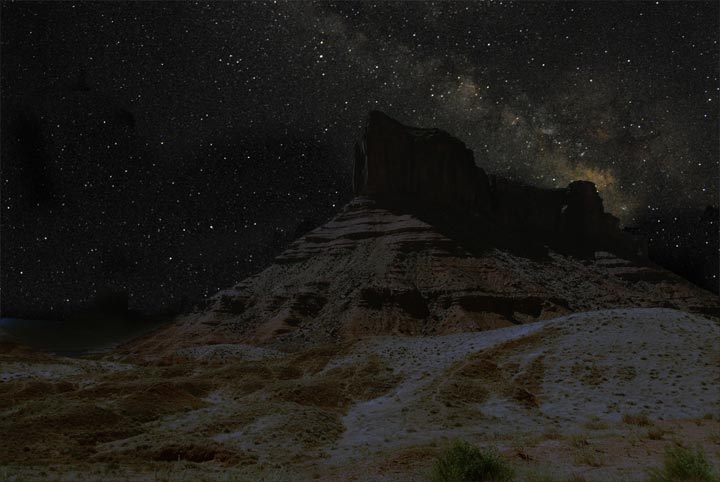
Now rollover it with your mouse to see what it started out like.
As it turns out, each of these cameras have many useful different kinds of pixel-film inside.
Wouldn't it be cool to interactively change an image into all these right in the middle of discussing them? Actually, you can achieve over 4000 permutations of image settings. It's in the eBook.
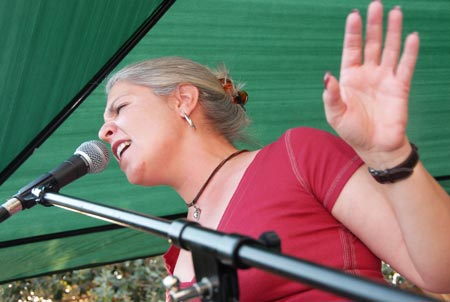 Lo and Behold; System Techniques
Lo and Behold; System Techniques
I know how to behold, but don't know how to "lo." LIfe seems full of stuff like that, I mean, when's the last time you purchased a rapidly selling hot cake? But I digress.
Since these cameras are the nexus of a photographic system, each is deeply intimate connection to the Nikon SB-800/600 flash units is a rich part of its feature set.
The camera has the ability to do some extraordinary things with its on-board speedlight, from delicate fill to expansive area illumination at high ISO.
Erica Lake sings, proving that one of the benefits from living in Hollywood is that the best talent show up at parties. Moreover, she's not only belting out a solid "Me and Bobby McGee" in a style Janis Joplin would have aspired to, but Erica is also showing how on-camera fill flash should best be used: Unobtrusively and with no more than 0.5 second's worth of setup fuss.
Fortunately for us, the D200 and D80 each do indeed have an on-board pop-up flash that rewards the photographer in many ways. Always instantly available for casual fill flash as Erica found out, it also acts as a Commander Mode controller of distant SB-800/600 units--reason enough to include on-camera flash for all future Nikon DSLRs. (D40/x cameras lack on-board Commander mode, but can command complex setups when mounted with a SB-800 unit.)
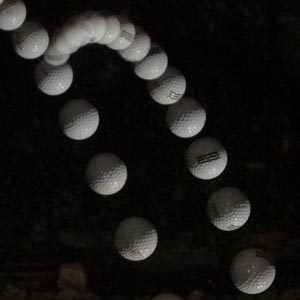 One of the D200/D80 camera flash tricks is to become a true Strobe! A repeating flash that sends a number of time-exact pulses during the shutter opening. On both cameras, it can fire off as many as 35 flashes in just under one second at 50 Hz. Each camera flash pulse is only 1/128th of full power, but at ISO 1000 that's still fast enough to catch multiple images of nearby subjects in mid flight.
One of the D200/D80 camera flash tricks is to become a true Strobe! A repeating flash that sends a number of time-exact pulses during the shutter opening. On both cameras, it can fire off as many as 35 flashes in just under one second at 50 Hz. Each camera flash pulse is only 1/128th of full power, but at ISO 1000 that's still fast enough to catch multiple images of nearby subjects in mid flight.
Too bad you can't use the Commander mode to trigger the SB-800 remotely to fire off a rapid string of pulses during the shutter opening.
Who said you can't?
In the eBook you will find out how to achieve exactly that. The picture at left shows numerous blasts from the SB-800's flash tube at f/16 using ISO 100, all of which were triggered wirelessly from the camera at a repeat rate of 50 Hz. Each visible blast was 1/64th of full power. Just for comparison, at 1/64 Power, the SB-800 has a nominal working range of 7 feet (2 m) when the D200 is jacked up to ISO 400.
Where this gets interesting is upon learning that the SB-800 was way the heck over there, and the camera that triggered each precision timed remote flash was way the heck over here. "Heck" in this case was only about ten feet, but we've done it with heck=30 feet.
Notice that the SB-800's light is coming from below and to the right of the golf balls. Dimmer camera light is filling in a little of the rest of the balls.That's the camera flash acting as a fill light. Both are in total sync. The camera told the SB when to fire every pulse precisely on cue. There's even a technique for doing this while eliminating the camera flash totally. Rollover and click for a longer shot and closer 1:1 crop from this image. Oh, I almost forgot. No wires. All synchronization is wireless. It's in the eBook.
[D400 users can achieve this true strobe effect with a mounted SB-800.]
Within these eBooks are some amazing new iNovaFX Actions. All of them are available. You saw the iBaby effect on page 1 of this report, but quick now, tell me how big was this model truck when I shot it?:
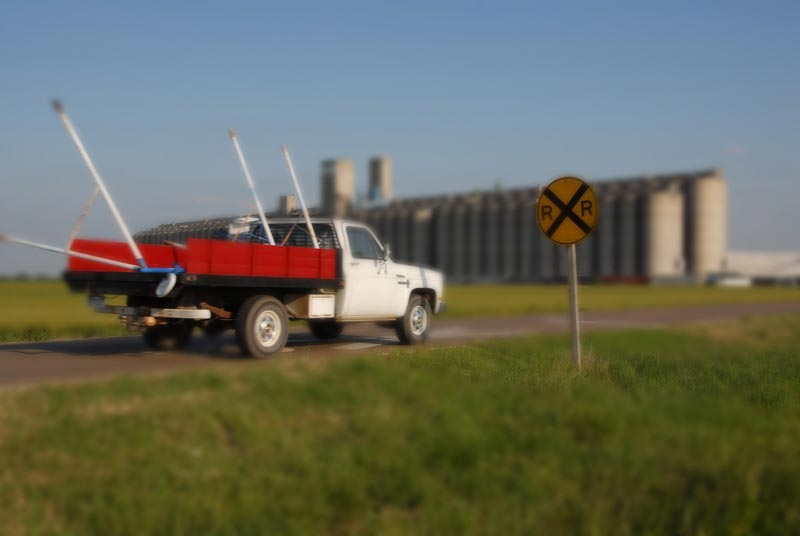
Unless you said "full size," you would be wrong. It's not a picture of a model truck at all. It's a real truck in a real setting. And the pictures you play with using the new iToy iNovaFX Photoshop Actions can gain the same sort of illustrative treatment.
As with many of the more advanced iNovaFX Actions, you will need to supply some skills while we supply the convenience.
Last count: well over 600 iNovaFX Actions including the new iToy and iBCFishGeoMAX series which you won't learn about until after the eBook arrives in the mail. And don't even get me started about iToons. Ok, just a quick note: Think cartoon, not music.
When I was a sprat, I realized I could draw a picture in 1/60th second with a camera. Photo art became ott (in my head) because it comes in shotts. It makes naming folders on my computer easier. Art here. Ott there. No confustication.
Wags will have to reinvent their jibes if this term ever becomes popular. Ottists. Ottsy Fottsy. It's hot, but is it Ott? Ott is anything you can get oway with...
Max the Parot. The D200 eBook even gives you his opinion about the original shot (he was very talkative when I first met him):
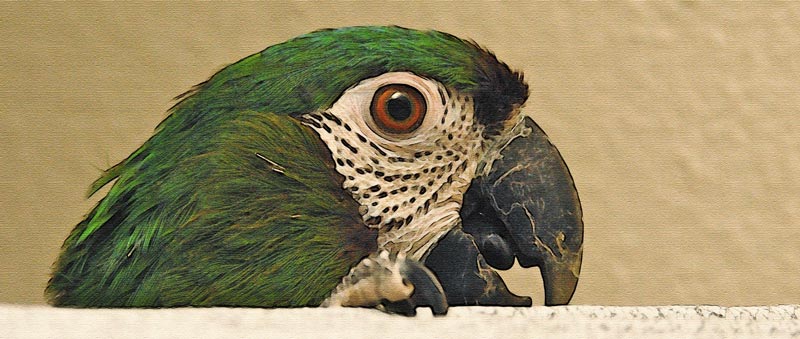
Rollover for nearly 1:1 chunk showing texture.
Much of these eBooks is concerned with image quality, quality images and crossing into the realm of compelling visuals that your cameras can deliver when you ask it to the right way.
Professional photographers take note: there are techniques, treatments and touches among the expanded iNovaFX Action sets that can move your images into new areas. Some of them can make you money.
You'll add your own tweaks, your own eye and your own pricing structure to the results they produce. Your rep will love the results. Any time he or she can pass pictures across the conference table that make clients' eyes widen predicts a good time for all.
When is the eBook Available?
As soon as the post office completes its appointed rounds. Order yours today.
Here's are your choices.
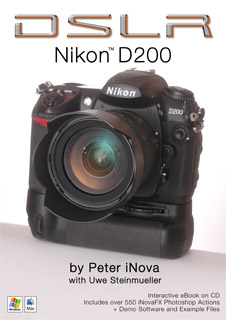
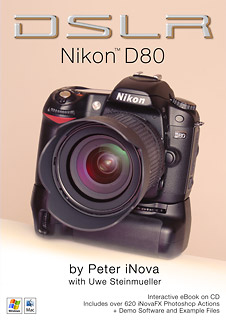
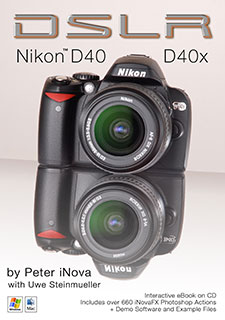
 Order one today. Each comes complete with all 620+ iNovaFX Photoshop Actions (over 660 in the D40/x eBook).
Order one today. Each comes complete with all 620+ iNovaFX Photoshop Actions (over 660 in the D40/x eBook).

